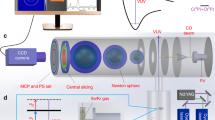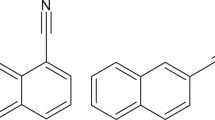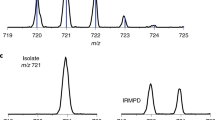Abstract
Chemical reactions are important in the evolution of low-temperature interstellar clouds, where the quantum tunnelling effect becomes significant. The F + para-H2 → HF + H reaction, which has a significant barrier of 1.8 kcal mol−1, is an important source of HF in interstellar clouds; however, the dynamics of this quantum-tunnelling-induced reactivity at low temperature is unknown. Here, we show that this quantum tunnelling is caused by a post-barrier resonance state. Quantum-state-resolved crossed-beam scattering measurements reveal that this resonance state has a collision energy of ~5 meV and a lifetime of ~80 fs, which are in excellent agreement with a recent anion photoelectron spectroscopic study. Accurate quantum reactive scattering calculations on the new iCSZ-LWAL potential energy surfaces provides a detailed explanation of the experimental results. The reaction rate for this system was also theoretically determined accurately at temperatures as low as 1 K.
This is a preview of subscription content, access via your institution
Access options
Access Nature and 54 other Nature Portfolio journals
Get Nature+, our best-value online-access subscription
$29.99 / 30 days
cancel any time
Subscribe to this journal
Receive 12 print issues and online access
$259.00 per year
only $21.58 per issue
Buy this article
- Purchase on Springer Link
- Instant access to full article PDF
Prices may be subject to local taxes which are calculated during checkout






Similar content being viewed by others
Data availability
Data supporting the findings of this study are available from the corresponding authors on request.
Code availability
The accurate iCSZ and iCSZ-LWAL PESs developed in this work are available from the corresponding authors on request.
References
Bell, R. P. The Tunnel Effect in Chemistry (Chapman & Hall, London, 1980).
Zuev, P. S. et al. Carbon tunnelling from a single quantum state. Science 299, 867–870 (2003).
Fleming, G. R., Scholes, G. D. & Cheng, Y. C. Quantum effects in biology. Procedia Chem. 3, 38–57 (2011).
Jankunas, J. & Osterwalder, A. Cold and controlled molecular beams: production and application. Annu. Rev. Phys. Chem. 66, 241–262 (2015).
Kaiser, R. I., Parker, D. S. N. & Mebel, A. M. Reaction dynamics in astrochemistry: low-temperature pathways to polycyclic aromatic hydrocarbons in the interstellar medium. Annu. Rev. Phys. Chem. 66, 43–67 (2015).
Wang, T. et al. Dynamical resonances in chemical reactions. Chem. Soc. Rev. 47, 6744–6763 (2018).
Neufeld, D. A., Zmuidzinas, J., Schilke, P. & Phillips, T. G. Discovery of interstellar hydrogen fluoride. Astrophys. J. 488, L141–L144 (1997).
Agundez, M. et al. HIFI detection of hydrogen fluoride in the carbon star envelope IRC+10216. Astron. Astrophys. 533, L6 (2011).
Monje, R. R. et al. Herschel/HIFI observations of hydrogen fluoride toward Sagittarius B2(M). Astrophys. J. Lett. 734, L23 (2011).
Indriolo, N., Neufeld, D. A., Seifahrt, A. & Richter, M. J. Direct determination of the HF/H2 abundance ratio in interstellar gas. Astrophys. J. 764, 188 (2013).
Berteloite, C. et al. Kinetics and dynamics of the S(1D2) + H2 → SH + H reaction at very low temperatures and collision energies. Phys. Rev. Lett. 105, 203201 (2010).
Lara, M. et al. Dynamics of the S(1D2) + H2 reaction at collision energies approaching the cold regime: a stringent test for theory. Phys. Rev. Lett. 109, 133201 (2012).
Lara, M. et al. Observation of partial wave structures in the integral cross section of the S(1D2) + H2(j = 0) reaction. Phys. Chem. Chem. Phys. 13, 8127–8130 (2011).
Tizniti, M. et al. The rate of the F + H2 reaction at very low temperatures. Nat. Chem. 6, 141–145 (2014).
Schatz, G. C. Detecting resonance. Science 288, 1599–1600 (2000).
Fernandez-Alonso, F. & Zare, R. N. Scattering resonances in the simplest chemical reaction. Annu. Rev. Phys. Chem. 53, 67–99 (2002).
Liu, K. Crossed-beam studies of neutral reactions: state-specific differential cross sections. Annu. Rev. Phys. Chem. 52, 139–164 (2001).
Liu, K. Quantum dynamical resonances in chemical reactions: from A + BC to polyatomic systems. Adv. Chem. Phys. 149, 1–46 (2012).
Yang, X. M. & Zhang, D. H. Dynamics resonances in the fluorine atom reaction with the hydrogen molecule. Acc. Chem. Res. 41, 981–989 (2008).
Schatz, G. C., Bowman, J. M. & Kuppermann, A. Large quantum effects in the collinear F + H2 → HF + H reaction. J. Chem. Phys. 58, 4023–4025 (1973).
Wu, S.-F., Johnson, B. R. & Levine, R. D. Quantum mechanical computational studies of chemical reactions: III. Collinear A + BC reaction with some model potential energy surfaces. Mol. Phys. 25, 839–856 (1973).
Neumark, D. M. et al. Molecular beam studies of the F + D2 and F + HD reactions. J. Chem. Phys. 82, 3067–3077 (1985).
Neumark, D. M., Wodtke, A. M., Robinson, G. N., Hayden, C. C. & Lee, Y. T. Molecular beam studies of the F + H2 reaction. J. Chem. Phys. 82, 3045–3066 (1985).
Aoiz, F. J. et al. Classical dynamics for the F + H2 → HF + H reaction on a new ab initio potential energy surface: a direct comparison with experiment. Chem. Phys. Lett. 223, 215–226 (1994).
Castillo, J. F., Manolopoulos, D. E., Stark, K. & Werner, H. J. Quantum mechanical angular distributions for the F + H2 reaction. J. Chem. Phys. 104, 6531–6546 (1996).
Stark, K. & Werner, H. J. An accurate multireference configuration interaction calculation of the potential energy surface for the F + H2 → HF + H reaction. J. Chem. Phys. 104, 6515–6530 (1996).
Ren, Z. et al. Probing the resonance potential in the F atom reaction with hydrogen deuteride with spectroscopic accuracy. Proc. Natl Acad. Sci. USA 105, 12662–12666 (2008).
Skodje, R. T. et al. Resonance mediated chemical reaction: F + HD → HF + D. Phys. Rev. Lett. 85, 1206 (2000).
Dong, W. R. et al. Transition state spectroscopy of partial wave resonances in the F + HD reaction. Science 327, 1501–1502 (2010).
Manolopoulos, D. E. et al. The transition state of the F + H2 reaction. Science 262, 1852–1855 (1993).
Kim, J. B. et al. Spectroscopic observation of resonances in the F + H2 reaction. Science 349, 510–513 (2015).
Qiu, M. H. et al. Observation of Feshbach resonances in the F + H2 → HF + H reaction. Science 311, 1440 (2006).
Wang, X. A. et al. HF(v′ = 3) forward scattering in the F + H2 reaction: shape resonance and slow-down mechanism. Proc. Natl Acad. Sci. USA 105, 6227–6231 (2008).
Qiu, M. H. et al. High resolution time-of-flight spectrometer for crossed molecular beam study of elementary chemical reactions. Rev. Sci. Instrum. 76, 083107 (2005).
Wang, T. et al. Dynamical resonances accessible only by reagent vibrational excitation in the F + HD → HF + D reaction. Science 342, 1499–1502 (2013).
Yang, T. G. et al. Extremely short-lived reaction resonances in Cl + HD(v = 1) → DCl + H due to chemical bond softening. Science 347, 60–63 (2015).
Neumark, D. M. Probing the transition state with negative ion photodetachment: experiment and theory. Phys. Chem. Chem. Phys. 7, 433–442 (2005).
Yu, D., Chen, J., Cong, S. L. & Sun, Z. Theoretical study of FH2 − electron photodetachment spectra on new ab initio potential energy surfaces. J. Phys. Chem. A 119, 12193–12208 (2015).
Blondel, C., Delsart, C. & Goldfarb, F. Electron spectrometry at the μeV level and the electron affinities of Si and F. J. Phys. At. Mol. Opt. Phys. 34, L281–L288 (2001).
Chen, J., Sun, Z. & Zhang, D. H. An accurate potential energy surface for the F + H2 → HF + H reaction by the coupled-cluster method. J. Chem. Phys. 142, 024303 (2015).
Skouteris, D., Castillo, J. F. & Manolopoulos, D. E. ABC: a quantum reactive scattering program. Comput. Phys. Commun. 133, 128–135 (2000).
Sun, Z., Zhang, D. H. & Alexander, M. H. Time-dependent wavepacket investigation of state-to-state reactive scattering of Cl with para-H2 including the open-shell character of the Cl atom. J. Chem. Phys. 132, 034308 (2000).
Sun, Z., Yang, W. T. & Zhang, D. H. Higher-order split operator schemes for solving the Schrödinger equation in the time-dependent wave packet method: applications to triatomic reactive scattering calculations. Phys. Chem. Chem. Phys. 14, 1827–1845 (2012).
Lique, F., Li, G. L., Werner, H.-J. & Alexander, M. H. Non-adiabatic coupling and resonances in the F + H2 reaction at low energies. J. Chem. Phys. 134, 231101 (2011).
Alexander, M. H., Manolopoulos, D. & Werner, H.-J. An investigation of the F + H2 reaction based on a full ab initio description of the open-shell character of the F(2P) atom. J. Chem. Phys. 113, 11084 (2000).
Weichman, M. L. et al. Feshbach resonances in the exit channel of the F + CH3OH → HF + CH3O reaction observed using transition-state spectroscopy. Nat. Chem. 9, 950–955 (2017).
Sternberg, A. & Neufeld, D. The ratio of ortho- to para-H2 in photodissociation regions. Astrophys. J. 516, 371–380 (1999).
Acknowledgements
C.X., Z.S., D.H.Z. and X.Y. acknowledge financial support for this research from the National Science Foundation of China (grants 21688102, 21590800, 21127902 and 21433009) and the Chinese Academy of Sciences (grants XDB 17010000). D.M.N. thanks the Air Force Office of Scientific Research for funding this research under grant no. FA9550-16-1-0097. M.H.A. thanks the US National Science Foundation for support under grant no. CHE-1565872.
Author information
Authors and Affiliations
Contributions
X.Y., D.H.Z., Z.S., C.X., D.M.N. and M.H.A. conceived and supervised the research. The experiments were carried out by T.Y., L.H., T.W., D.D. and C.X. Data analysis and interpretation were performed by T.Y., L.H., T.W., D.D., C.X. and X.Y. Theoretical calculations were performed by Z.S., J.C., F.L., M.H.A. and D.H.Z. The manuscript was written by X.Y., Z.S., M.H.A., D.Z. and D.M.N., with contributions from all authors. All authors contributed to discussions about the content of the paper.
Corresponding authors
Ethics declarations
Competing interests
The authors declare no competing interests.
Additional information
Publisher’s note: Springer Nature remains neutral with regard to jurisdictional claims in published maps and institutional affiliations.
Supplementary information
Supplementary Information
Supplementary Figs. 1–9, Supplementary Tables 1 and 2, Supplementary methods
Rights and permissions
About this article
Cite this article
Yang, T., Huang, L., Xiao, C. et al. Enhanced reactivity of fluorine with para-hydrogen in cold interstellar clouds by resonance-induced quantum tunnelling. Nat. Chem. 11, 744–749 (2019). https://doi.org/10.1038/s41557-019-0280-3
Received:
Accepted:
Published:
Issue Date:
DOI: https://doi.org/10.1038/s41557-019-0280-3
This article is cited by
-
Enhancing reactivity of SiO+ ions by controlled excitation to extreme rotational states
Nature Communications (2023)
-
Tunnelling measured in a very slow ion–molecule reaction
Nature (2023)
-
H2 formation via non-Born-Oppenheimer hydrogen migration in photoionized ethane
Nature Communications (2023)
-
Real-time hydrogen molecular dynamics satisfying the nuclear spin statistics of a quantum rotor
Communications Chemistry (2022)
-
Towards chemistry at absolute zero
Nature Reviews Chemistry (2021)



